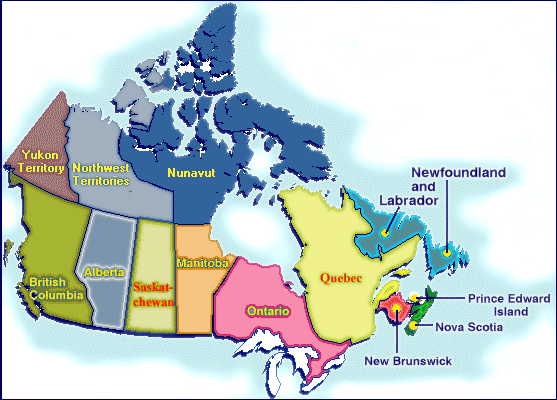

HAPPY NEW YEAR 2019
BONNE ANNÉE 2019
SZCZĘŚLIWEGO NOWEGO ROKU 2019
FELIZ AÑO NUEVO 2019


TROYAK EXECUTIVE TEAM is informing all members, colleagues, collectors and Polonia at large, that Club meetings taking place at John Paul II Polish Cultural Centre, 4300 Cawthra Rd. (just south of Hwy. 403), Mississauga, Ontario. The new members are always welcome. www.polishculturalcentre.ca
ADRES SPOTKAÑ KLUBOWYCH ! Zarząd Główny Klubu “Troyak” informuje wszystkich członków kolekcjonerów, sympatyków oraz całą Polonię, że spotkania klubowe odbywają się w Polskim Centrum Kultury im. Jana Pawła II, przy 4300 Cawthra Rd. (na południe od autostrady 403), Mississauga, Ontario. Zapraszamy nowych członków do prężnego. Klubu “Troyak”. www.polishculturalcentre.ca

“TROYAK” CLUB NEXT MEETINGS …
NASTĘPNE SPOTKANIA KLUBU “TROYAK” …
13th January 2019 @ 4:30 p.m. … Annual General Meeting
27th January 2019 @ 4:30 p.m.
24th February 2019

3rd March 2019 …
XVI Polish – Canadian Coin, Stamp & Collectibles Show 2019
31st March 2019 @ 4:30 p.m.
28th April 2019; 26th May 2019; 23rd June 2019
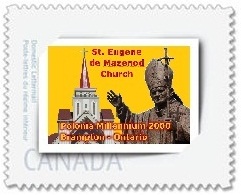
July & August 2019 – Summer break … Letnie wakacje …
29th September 2019
6th October 2019 @ 9:00 a.m. to 4:00 p.m. …
Mississauga’s Coin & Stamp Show 2019
27th October 2019; 24th November 2019

Sunday, MARCH 3, 2019, Mississauga, Ontario
XVI Polish – Canadian Coin, Stamp & Collectibles Show 2019
at John Paul II Polish Cultural Centre
4300 Cawthra Rd. (just south of Hwy. 403). Mississauga, Ontario.
SUNDAY 9 am to 4 pm with $5 adult admission.
Kids 16 and under Free. Free parking.
30+ DEALERS of CANADIAN and INTERNATIONAL Stamps, Gold and Silver Coins,
Royal Canadian Mint Coins, Paper Money, Military and other Collectibles.
Bring coins, stamps or collectibles to be evaluated and get best prices.
Organized by the Polish-Canadian Coin & Stamp Club (Troyak Club) …
… offering free stamps for kids.
See www.troyakclub.com for details.
More information: Contact Les Plonka – leszekp@rogers.com or call (416) 505-7999 …
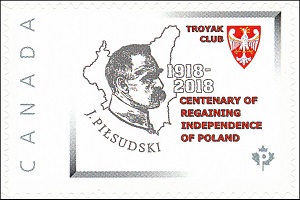
Special Medal by Consulate of Poland & Troyak Club
www.troyakclub.com
The idea to issue a medal for the 100th anniversary of Poland regaining its Independence started several months ago. The Consulate General of Poland in Toronto was approached to see if they would like to sponsor such medal. They agreed to cover the costs of the dies and the design. The designer, Dorothy Baniak, undertook the challenge to design a Polish-Canadian themed medal. It took few tries to become what it is now. Medal will be struck in silver and copper. The medal will be ready for distribution in February/March 2019 timeframe. Email info@troyakclub.com for information on ordering the medal, stamps or covers.
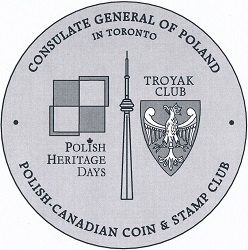
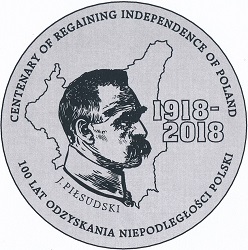
Final design of the Medal. Designer: Dorothy Baniak …
“DESIGN-Consulate-Troyak SIDE” & “DESIGN-PILSUDSKI SIDE”.
Medal specifications: Silver: 0.9999 Fine Silver 1 oz. in plastic capsule.
Copper: Alloy #110 Copper in plastic capsule.
Size: 3.30 mm x 38.00 mm dia.
Non-Member Cost: Silver $70 CAD; Copper $15 CAD.

50. rocznica koronacji figury Matki Bożej Piaseckiej
50th Anniversary of the Coronation of the Image of Our Lady of Piaseczno
www.poczta-polska.pl

Wartość: A … autor projektu kartki: K. Tabaka;
liczba znaczków: 1; nakład: 8 000 szt.;
technika druku: offset; format kartki: 148 x 105 mm
data wprowadzenia do obiegu: 8 września 2018 r.

100-lecie utworzenia Ligi Morskiej i Rzecznej
100th anniversary of the creation of the Maritime and River League
www.poczta-polska.pl
Dnia 29 września 2018 r. została wprowadzona do obiegu kartka pocztowa z nadrukowanym znakiem opłaty pocztowej, emisji: 100-lecie utworzenia Ligi Morskiej i Rzecznej. Wartość nominalna znaku opłaty pocztowej z oznaczeniem literowym A odpowiada wartości nominalnej znaczka pocztowego używanego do uiszczenia opłaty za ekonomiczną przesyłkę listową nierejestrowaną, w tym kartkę pocztową, w obrocie krajowym, o masie do 350 g. W prawym górnym rogu strony adresowej kartki nadrukowano znak opłaty pocztowej, na którym przedstawiono trzy odznaki Ligi Morskiej i Rzecznej; wzdłuż dolnej krawędzi znaczka umieszczono napis: POLSKA; a w lewym górnym rogu oznaczenie wartości A. W części ilustracyjnej kartki znajdują się: *1) nazwa emisji: 100-lecie utworzenia Ligi Morskiej i Rzecznej, *2) fotografia przedstawiająca STS Generał Zaruski.
Wartość: A … autor projektu kartki: K. Tabaka;
liczba znaczków: 1; nakład: 8 000 szt.;
technika druku: offset; format kartki: 148 x 105 mm;
data wprowadzenia do obiegu: 29 września 2018 r.
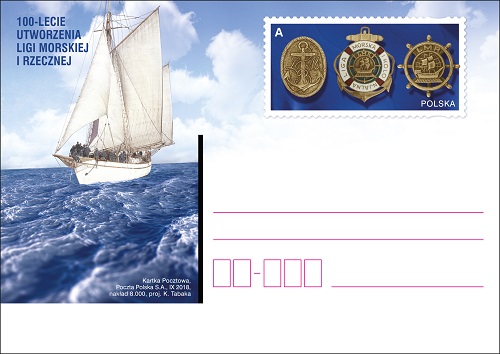
100th anniversary of the creation of the Maritime and River League …
denomination: 2,60 PLN; number of stationeries in set: 1;
print run: 8.000 pcs; printing technique: offset; card size: 148 x 105 mm;
release date: 29th September 2018; author: Karol Tabaka.

XXII Ogólnopolska Wystawa Filatelistyczna Poznań 2018
XXII National Philatelic Exhibition Poznań 2018
www.poczta-polska.pl
Wartość: 2,60 zł … autor projektu: Jacek Konarzewski;
liczba znaczków: 1; nakład: w wersji perforowanej – 204 000 szt.,
w wersji nieperforowanej – 108 000 szt.; technika druku: offset;
format znaczka: 31,25 x 43 mm; arkusz sprzedażny: 12 znaczków + 4 przywieszki;
papier: fluorescencyjny; data wprowadzenia do obiegu: 3 października 2018 r.
Z tej okazji została wydana również koperta FDC.

XXII National Philatelic Exhibition Poznań 2018 … denomination: 2,60 PLN;
print run: 204.000 pcs. perforated, 108.000 pcs. Imperforated;
printing techniques: offset paper: fluorescent; stamp size: 31,25 x 43 mm;
circulation date: 03rd October 2018; number of FDC: 1;
author: Jacek Konarzewski.

Walor filatelistyczny związany z obchodzonymi w 2018 roku ważnymi rocznicami historycznymi został wydany w arkuszu zawierającym 12 znaczków i 4 przywieszki. Zgodnie z zamysłem autorskim Jacka Konarzewskiego, ilustracja na znaczku przedstawia fragment wieży ratusza w Poznaniu z zegarem i koziołkami. Na pierwszej przywieszce znajduje się logo obecnej edycji wystawy w Poznaniu z odniesieniem do 100. rocznicy odzyskania przez Polskę niepodległości. Druga przywieszka prezentuje logo Polskiego Związku Filatelistów wraz z podtytułem 50-lecie Międzynarodowej Wystawy Filatelistycznej „Tematica-Poznań ’68”. Trzecia przywieszka ukazuje herb województwa wielkopolskiego, nawiązując jednocześnie do 100. rocznicy wybuchu Powstania Wielkopolskiego, na ostatniej zaś widnieje logo Poczty Polskiej, która w 2018 roku obchodziła swoje 460-lecie powstania. Ta ważna Ogólnopolska Wystawa Filatelistyczna w Poznaniu została zorganizowana m.in. dla uczczenia 100. rocznicy wybuchu Powstania Wielkopolskiego i 100. rocznicy odzyskania przez Polskę niepodległości. W ten sposób nawiązuje do historycznej I Wystawy Polskich Marek Pocztowych, która miała miejsce w Warszawie w 1919 r. Ostatnia edycja odbyła się z okazji 95-lecia Polskiego Komitetu Olimpijskiego w 2014 r.

Kard. August Hlond – Prymas Polski Odrodzonej
Cardinal August Hlond – Primate of Poland Reborn
www.poczta-polska.pl
Wartości: 5 zł … autor projektu: Jarosław Ochendzan; liczba znaczków: 1;
nakład: 1 000 000 szt.; technika druku: rotograwiura; papier: fluorescencyjny;
format znaczków: 25,5 x 31,25 mm; arkusze sprzedażne: po 100 znaczków;
data wprowadzenia do obiegu: 22 października 2018 r.
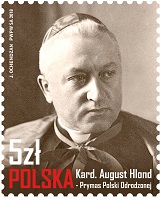
Cardinal August Hlond – Primate of Poland Reborn …
denomination: 5,00 PLN; number of stamps in set: 1;
print run: 1000.000 pcs.; printing techniques: rotogravure;
paper: fluorescent; stamp size: 25,5 x 31,25 mm, 100 pcs. in sheet;
number of FDC: 1; author: Jarosław Ochendzan; circulation date: 22nd October 2018.

125 lat Teatru im. J. Słowackiego w Krakowie
125 years of the J. Słowacki Theatre in Kraków
www.poczta-polska.pl
Dnia 23 października 2018 r. została wprowadzona do obiegu kartka pocztowa z nadrukowanym znakiem opłaty pocztowej, emisji: 125 lat Teatru im. J. Słowackiego w Krakowie. Wartość nominalna znaku opłaty pocztowej z oznaczeniem literowym A odpowiada wartości nominalnej znaczka pocztowego używanego do uiszczenia opłaty za ekonomiczną przesyłkę listową nierejestrowaną, w tym kartkę pocztową, w obrocie krajowym, o masie do 350 g. W prawym górnym rogu strony adresowej kartki nadrukowano znak opłaty pocztowej, na którym przedstawiono autoportret Stanisława Wyspiańskiego; w prawym górnym rogu znaczka umieszczono oznaczenie wartości: A, wzdłuż prawej krawędzi znaczka umieszczono napis POLSKA; poza znaczkiem, wzdłuż jego prawej krawędzi umieszczono napis: Stanisław Wyspiański, Autoportret, 1894 r., Muzeum Narodowe w Warszawie. W części ilustracyjnej kartki znajdują się: *1. w tle pola adresowego – fotografia wnętrza Teatru im. J. Słowackiego z widokiem na scenę główną, *2. w formie kotary – grafika autorstwa J. Zawiejskiego, przedstawiająca budynek Teatru, *3. nazwa emisji: ,,125 lat Teatru im. J. Słowackiego w Krakowie”, *4. opis: ,,Otwarty 21 X 1893 r. w gmachu wg projektu Jana Zawiejskiego. Początkowo pod nazwą Teatr Miejski. Miejsce prapremier najważniejszych dzieł Stanisława Wyspiańskiego, m.in. Wesela w 1901 r.”
Wartość: A … autor projektu kartki: K. Tabaka; liczba znaczków: 1;
nakład: 8 000 szt.; technika druku: offset; format kartki: 148 x 105 mm;
data wprowadzenia do obiegu: 23 października 2018 r.

125 years of the J. Słowacki Theatre in Kraków … denomination: 2,60 PLN;
number of stationeries in set: 1; print run: 8.000 pcs; author: K.Tabaka;
printing technique: offset; card size: 148 x 105 mm;
release date: 23rd October 2018.

100 – lecie Związku Harcerstwa Polskiego
www.poczta-polska.pl
Dnia 01 listopada 2018 r. została wprowadzona do obiegu kartka pocztowa z nadrukowanym znakiem opłaty pocztowej, emisji: 100- lecie Związku Harcerstwa Polskiego. Wartość nominalna znaku opłaty pocztowej z oznaczeniem literowym A odpowiada wartości nominalnej znaczka pocztowego używanego do uiszczenia opłaty za ekonomiczną przesyłkę listową nierejestrowaną, w tym kartkę pocztową, w obrocie krajowym, o masie do 350 g. W prawym górnym rogu strony adresowej kartki nadrukowano znak opłaty pocztowej, na którym przedstawiono fotografię Olgi Drahonowskiej-Małkowskiej i Andrzeja Małkowskiego, twórców polskiego harcerstwa; w lewym dolnym rogu znaczka umieszczono oznaczenie wartości: A, a w lewym górnym rogu napis: Polska; pod znaczkiem umieszczono napis: ,,Olga Drahonowska-Małkowska i Andrzej Małkowski – twórcy polskiego harcerstwa”.
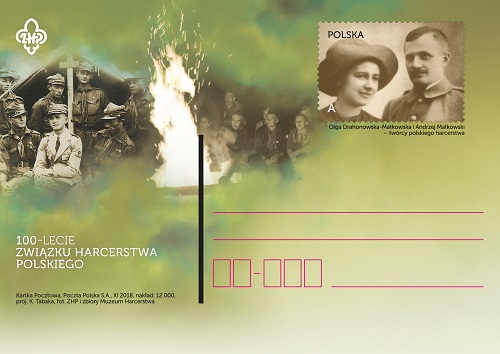
W części ilustracyjnej kartki znajdują się: *1)historyczna fotografia ze zbiorów Muzeum Harcerstwa, przedstawiająca harcerzy przed namiotem, *2)współczesna fotografia harcerzy przy ognisku, *3)nazwa emisji: 100-LECIE ZWIAZKU HARCERSTWA POLSKIEGO, *4)logotyp Związku Harcerstwa Polskiego. Kartkę o wymiarach 148 x 105 mm wydrukowano jednostronnie, techniką offsetową, na kartonie białym, w nakładzie 12000 sztuk. Autor projektu kartki: K.Tabaka.

Pierwsze dni niepodległości
First days of Independence
www.poczta-polska.pl

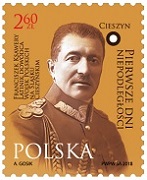
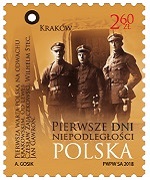
Wartość: 5 x 2,60 zł … autor projektów: Andrzej Gosik;
liczba znaczków: 5; nakład: po 100.000 sztuk każdego;
technika druku: offset; arkusz sprzedażny: 5 znaczków;
format znaczków: 31,25 x 25,5 mm i 25,5 x 31,25 mm;
papier: samoprzylepny, fluorescencyjny
data wprowadzenia do obiegu: 11 listopada 2018 r.
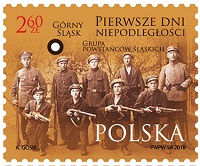

First days of Independence … denomination: 2,60 PLN;
number of stamps in set: 5; printing technique: offset;
print run: 100.000 pcs; author: Andrzej Gosik;
stamp size: 31,25 x 25,5 mm i 25,5 x 31,25 mm;
release date: 11th November 2018.
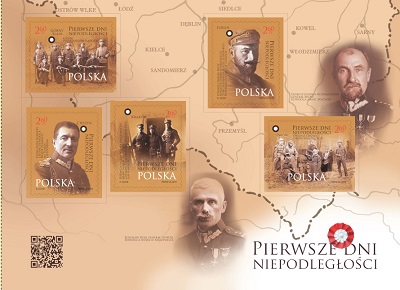
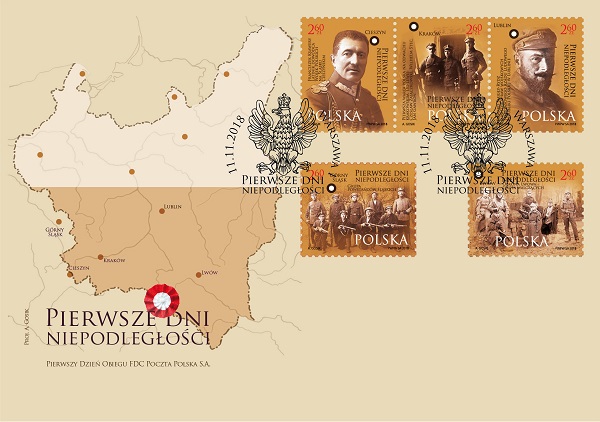

Wojsko Odrodzonej Rzeczypospolitej
Army of the Reborn Republic of Poland
www.poczta-polska.pl
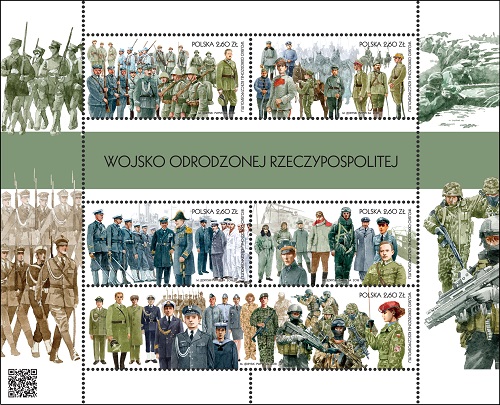
Emisja „Wojsko Odrodzonej Rzeczypospolitej” przedstawia ilustracje wybranych jednostek militarnych Rzeczypospolitej z ostatniego stulecia. Na znaczkach znajdują się wizerunki żołnierzy lądowych, kawalerii, artylerii konnej, marynarki wojennej oraz lotnictwa. Na jednym ze znaczków umieszczono ilustracje przedstawiające współczesne siły zbrojne Rzeczypospolitej, tj. Wojska Lądowe, Siły Powietrzne, Wojska Marynarki Wojennej, Wojska Specjalne i Wojska Obrony Terytorialnej. Autorem projektów znaczków jest Maciej Jędrysik.
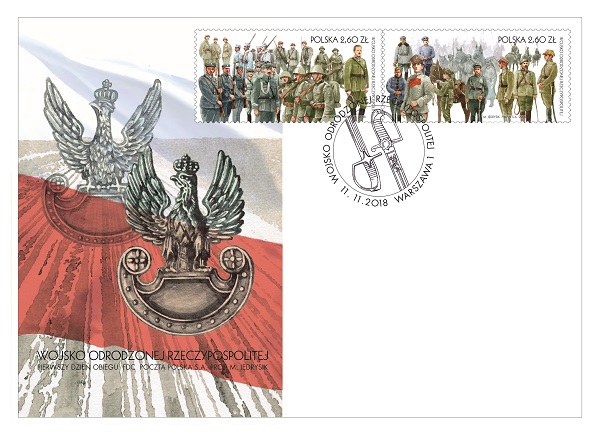
Wartość: 5 x 2,60 zł … autor projektu: Maciej Jędrysik;
liczba znaczków: 5; nakłady: po 100 000 szt. Każdego;
technika druku: rotograwiura; papier: fluorescencyjny;
format znaczków: 54×27 mm (4 znaczki), 108×27 (1 znaczek)
arkusz sprzedażny: 5 różnych znaczków;
data wprowadzenia do obiegu: 11.11. 2018 r.
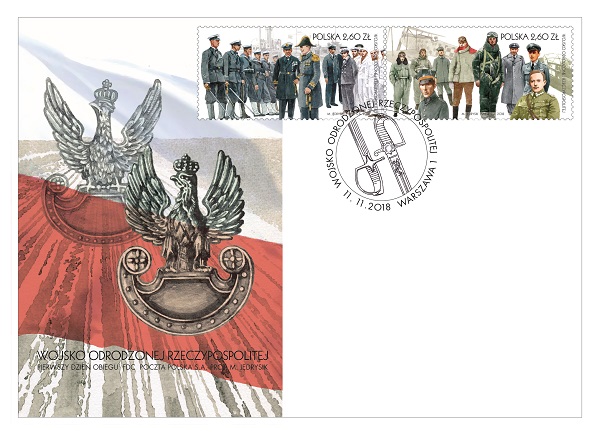
Army of the Reborn Republic of Poland … denomination: 2,60 PLN;
number of stamps in set: 5; printing technique: photogravure;
print run: 100.000 pcs; author: Maciej Jędrysik;
stamp size: 54×27 mm (4 stamps), 108×27 (1 stamp);
release date: 11th November 2018.
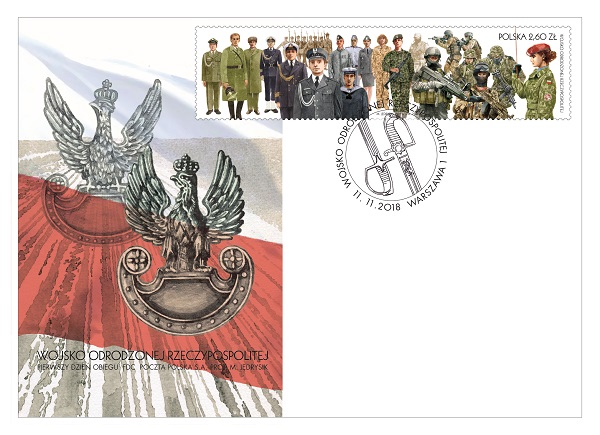

Konferencja Narodów Zjednoczonych w sprawie zmian klimatu COP24
COP24 United Nations Climate Change Conference
www.poczta-polska.pl
Dnia 03 grudnia 2018 r. została wprowadzona do obiegu kartka pocztowa z nadrukowanym znakiem opłaty pocztowej, emisji: Konferencja Narodów Zjednoczonych w sprawie zmian klimatu COP24. Wartość nominalna znaku opłaty pocztowej z oznaczeniem literowym A odpowiada wartości nominalnej znaczka pocztowego używanego do uiszczenia opłaty za ekonomiczną przesyłkę listową nierejestrowaną, w tym kartkę pocztową, w obrocie krajowym, o masie do 350 g. W prawym górnym rogu strony adresowej kartki nadrukowano znak opłaty pocztowej, na którym przedstawiono logo COP24 Katowice 2018 United Nations Climate Change Conference; na prawej krawędzi znaczka umieszczono napis: POLSKA, a w prawym górnym rogu oznaczenie wartości A. W części ilustracyjnej kartki znajdują się: *1) nazwa emisji: Konferencja Narodów Zjednoczonych w sprawie zmian klimatu COP24; *2) grafika przedstawiająca charakterystyczne elementy architektury Katowic: Spodek, Międzynarodowe Centrum Kongresowe, Osiedle Walentego Roździeńskiego (nazywane potocznie Os. Gwiazdy), Dworzec Główny PKP – wkomponowane w zielony krajobraz.
Wartość: A … autor projektu: K. Tabaka; liczba znaczków: 1;
nakład: 8 000 szt.; technika druku: offset;
format kartki: 148 x 105 mm;
data wprowadzenia do obiegu: 3 grudnia 2018 r.

COP24 United Nations Climate Change Conference …
denomination: 2,60 PLN; number of stationeries in set: 1;
print run: 8.000 pcs; printing technique: offset; author: K. Tabaka;
card size: 148 x 105 mm; release date: 03rd December 2018.
COP24 to jedno z najważniejszych międzynarodowych wydarzeń poświęconych działaniom na rzecz klimatu, która odbyła się w Katowicach w dniach 2–14 grudnia 2018 roku. Konferencja w Katowicach zgromadziła delegatów z ponad 200 państw, wśród nich byli przedstawiciele nauki, biznesu, organizacji pozarządowych oraz ekologicznych. Podczas COP (ang. Conference of the Parties, tj. szczytu klimatycznego ONZ) dyskusja dotyczyła działań na rzecz polityki klimatycznej. W poniedziałek 3 grudnia 2018 r. odbył się Szczyt Liderów pod auspicjami Prezydenta RP Andrzeja Dudy z udziałem m.in. Sekretarza Generalnego ONZ Antonia Gutierresa oraz wielu światowych przywódców. Decyzja o organizacji szczytu klimatycznego COP24 w Polsce zapadła podczas szczytu COP22 w Marrakeszu. Wybór Katowic, jako lokalizacji wydarzenia, leżał po stronie ONZ i został ogłoszony 1 czerwca 2017 r. Polska po raz czwarty przewodniczyła Konferencji Stron, a po raz trzeci gościła konferencję szczytu – poprzednie zorganizowane w Polsce to COP14 w 2008 r. w Poznaniu oraz COP19 w 2013 r. w Warszawie.
Poczta Polska będąca jedną ze strategicznych spółek państwowych podejmuje szereg działań na rzecz ekologii. Firma inwestuje w nowoczesne i inteligentne systemy oświetlania w swoich sortowniach i stawia na zmniejszenie zużycia energii elektrycznej. W myśl ustawy z 11 stycznia 2018 roku o elektromobilności i paliwach alternatywnych, Polska stawia na rozwój transportu niskoemisyjnego. Przyjęte w ustawie rozwiązania powodują konieczność stopniowej wymiany floty zasilanej paliwami tradycyjnymi. Poczta w kwietniu i październiku przeprowadziła testy pojazdów elektrycznych. Firma przygotowuje się docelowo do wprowadzenia stref czystego transportu. Podobne regulacje do wymienionej ustawy o elektromobilności wprowadzone zostały w większości krajów Unii Europejskiej. Skutkiem tego jest powszechne wprowadzanie do floty, pojazdów elektrycznych (np. w pocztach Niemiec, Francji, Danii), co jest poprzedzane szczegółowymi testami.

Wyklęci przez komunistów żołnierze niezłomni
– Hieronim Dekutowski, „Zapora”
www.nbp.pl
Narodowy Bank Polski ma wyłączne prawo emitowania znaków pieniężnych Rzeczypospolitej Polskiej, w tym monet i banknotów kolekcjonerskich. Wszystkie monety i banknoty emitowane przez NBP są prawnym środkiem płatniczym w Polsce. 5 grudnia 2018 roku Narodowy Bank Polski wprowadził do obiegu srebrną monetę o nominale 10 zł z serii Wyklęci przez komunistów żołnierze niezłomni. Na rewersie monety znajdują się wizerunki: Hieronima Dekutowskiego ps. „Zapora”, orderu Virtuti Militarii, biało-czerwonej flagi z symbolem Polski Walczącej oraz napis „Zachowali się jak trzeba”. Na każdej polskiej monecie znajdują się: nominał, napis „Rzeczpospolita Polska”, rok emisji, wizerunek orła ustalony dla godła Rzeczypospolitej Polskiej.
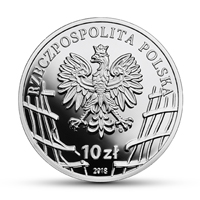
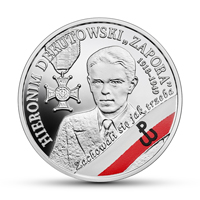
Nominał 10 zł … Metal: Ag925; Stempel: lustrzany; Średnica: Ø 32,00mm;
Masa: 14,14 g; Brzeg (bok): gładki; Nakład: do 15 000;
Projektant monety: Dobrochna Surajewska; Data emisji: 05-12-2018;
Emitent: NBP; Na zlecenie NBP monety wyprodukowała
Mennica Polska S.A.
Major Wojska Polskiego Hieronim Dekutowski urodził się 24 września 1918 r. w Tarnobrzegu. Aktywna postawa odpowiedzialności patriotycznej cechowała Dekutowskiego już w latach młodzieńczych. Harcerz drużyny im. Jana Henryka Dąbrowskiego, członek Sodalicji Mariańskiej. Podczas wojny obronnej 1939 r. był ochotnikiem, 17 września przekroczył granicę z Węgrami i został internowany. Z obozu jednak uciekł i przedostał się do Francji, gdzie w Polskich Siłach Zbrojnych walczył z Niemcami. Następnie został ewakuowany do Anglii. W marcu 1943 r., zaprzysiężony jako cichociemny, przyjął pseudonimy „Zapora” i „Odra”(używał głównie tego pierwszego). W nocy z 16 na 17 września 1943 r. w ramach operacji zrzutu cichociemnych („Neon 1″) Hieronim Dekutowski trafił do placówki „Garnek” 103 w okolicach Wyszkowa.
Lot z Anglii halifaksem BB-378 „D”, należącym do dywizjonu RAF, trwał 12 godzin i 30 minut. Początkowo Dekutowski dowodził oddziałem AK w Inspektoracie Zamość, broniąc ludność Zamojszczyzny przed wysiedleniami. W styczniu 1944 r. został szefem Kedywu AK w Inspektoracie Lublin − Puławy. Jeden z żołnierzy tak go zapamiętał: „Wkrótce zyskał opinię wybitnego dowódcy. Cechowała go odwaga, szybkość decyzji, a jednocześnie ostrożność i ogromne poczucie odpowiedzialności za ludzi. Znakomicie wyszkolony w posługiwaniu się bronią ręczną i maszynową, niepozorny, ale obdarzony wielkim czarem osobistym, umiał być wymagający i utrzymywał żelazną dyscyplinę w podległych mu oddziałach, co w połączeniu z umiarem i troską o każdego żołnierza zapewniało mu u podkomendnych ogromny mir. Nazywali go »Starym«, choć nie miał jeszcze trzydziestu lat”. Dwustuosobowy oddział „Zapory” przeprowadził 83 akcje bojowe i dywersyjne. Brał udział w akcji „Burza” na Lubelszczyźnie, po czym bezskutecznie próbował przedrzeć się na pomoc walczącej Warszawie. Po wejściu Sowietów Dekutowski nie złożył broni. W odpowiedzi na komunistyczny terror stworzył poakowski oddział samoobrony, liczący, podobnie jak w czasie niemieckiej okupacji, około 200 osób. Dokonał wielu brawurowych akcji odwetowych na NKWD, UB, KBW i MO. Jako najwybitniejszemu dowódcy podporządkowała mu się większość oddziałów Zrzeszenia Wolność i Niezawisłość (WiN) na Lubelszczyźnie.
Walce o wolną Ojczyznę poświęcił nawet prywatne życie. Ukochanej narzeczonej powiedział: „Idę do lasu, nie wiem, czy przeżyję, nie możemy być razem”. „Zapora” razem z dowódcami pododdziałów swojego zgrupowania został aresztowany przez komunistyczną bezpiekę we wrześniu 1947 r. w Nysie. Przewiezionych do aresztu śledczego na Rakowiecką w Warszawie poddano brutalnemu śledztwu. 15 listopada 1948 r. komunistyczny sąd skazał siedmiu „Zaporczyków” na kilkakrotne kary śmierci. Hieronim Dekutowski został zamordowany strzałem w tył głowy 7 marca 1949 r. Jego szczątki odnaleziono i zidentyfikowano dopiero w 2013 r. Przez długie lata PRL-u komuniści zakłamywali jego życiorys. Inaczej było na Zachodzie, gdzie w 1964 r. legalny Rząd Rzeczypospolitej Polskiej na uchodźstwie przyznał pośmiertnie mjr. „Zaporze” Srebrny Krzyż Virtuti Militari. Dopiero w 1994 r. Sąd Wojewódzki w Warszawie uznał, że Hieronim Dekutowski i jego zamordowani podkomendni prowadzili działalność na rzecz niepodległego bytu Państwa Polskiego. Informacja: Tadeusz Płużański.

The Enduring Soldiers Accursed by the Communists
– Hieronim Dekutowski ‘Zapora’
www.nbp.pl
Narodowy Bank Polski holds the exclusive right to issue the currency of the Republic of Poland, including collector coins and banknotes. All coins and banknotes issued by NBP are legal tender in Poland. All Polish coins feature: face value, image of the Eagle established as the state emblem of the Republic of Poland inscription: Rzeczpospolita . On 5 December 2018, Narodowy Bank Polski issued into circulation a silver coin of the series “The Enduring Soldiers Accursed by the Communists”, with a face value of 10 zł. The reverse of the coin carries the images of Hieronim Dekutowski alias Zapora, the Order of Virtuti Militari, a white and red flag with the symbol of Fighting Poland, and the inscription “They acted as they should”. The obverse of the silver coin depicts broken prison bars.


Face value 10 zł. … Metal: Ag 925/1000; Finish: proof, pad printing;
Diameter: 32.00 mm; Weight: 14.14 g; Edge (side): plain;
Mintage: up to 15,000 pcs; Coin designer: Dobrochna Surajewska;
Issuer: NBP Polska, The coins, commissioned by NBP, were struck
by Mennica Polska S.A. Year of issue: 5 December 2018.
Polish Army Major Hieronim Dekutowski was born on 24 September 1918 in Tarnobrzeg. Dekutowski was characterized by an active attitude of patriotic responsibility already in his youth. He belonged to the “Jan Henryk Dąbrowski” Scout Team and was a member of the Sodality of the Blessed Virgin Mary. He fought as a volunteer in the Polish defensive war of 1939, and on 17 September he crossed the border with Hungary, where he was interned. He escaped from the internment camp and fled to France, where he fought against the Germans as a member of the Polish Armed Forces. He was then evacuated to England. In March 1943 he has sworn in as a member of the so-called “Cichociemni” (the Silent Unseen) paratroopers. He adopted the pseudonyms “Zapora” and “Odra” (he mainly used the first one, however). On the night of 16-17 September 1943 Hieronim Dekutowski was sent to the “Garnek” 103 outposts in the vicinity of Wyszków, as part of the “Neon 1” operation during which members of the Silent Unseen paratroopers were parachuted into the Polish territory.
The flight from England aboard the Halifax BB-378 “D” aeroplane, which belonged to the RAF, lasted 12 hours and 30 minutes. Dekutowski initially commanded the Home Army unit in the Zamość Inspectorate, defending the people of the Zamość region against forced expulsions. In January 1944 he became the head of the Home Army’s Directorate for Subversion (“Kedyw”) in the Inspectorate of Lublin – Puławy. One of his fellow soldiers recalled him in the following way: “He soon gained the opinion of an outstanding commander. He was characterized by courage, swift decision-making skills, and at the same time, caution and a great sense of responsibility for the people. He was thoroughly trained in the use of handguns and machine guns. He was inconspicuous but also had great personal charm. He knew how to be demanding and he maintained iron discipline in his units, but he also combined that with moderation and concern for each soldier, as a result of which he was held in high esteem by his subordinates. They referred to him as “the old man” even though he was not yet thirty.”
Dekutowski’s unit consisted of two hundred men and carried out 83 combat operations and subversive activities. He took part in “Operation Tempest” (Akcja “Burza”) in the Lublin region, after which he unsuccessfully attempted to break through to the capital in order to help the soldiers fighting in the Warsaw Uprising. Dekutowski did not lay down his arms after the Soviet forces entered Poland. In response to the communist terror, he created a post-Home Army self-defense unit, which consisted of about 200 men, just like during the German occupation. He conducted many courageous retaliatory actions against the Soviet Union’s NKVD, as well as the Department of Security (Urząd Bezpieczeństwa – UB), the Internal Security Corps (Korpus Bezpieczeństwa Wewnętrznego – KBW) and the Citizens’ Militia (Milicja Obywatelska – MO). Because he was the most distinguished commander of the underground resistance, the majority of the Freedom and Independence (Zrzeszenie Wolność i Niezawisłość) units in the Lublin region submitted to his leadership. He even sacrificed his private life to the struggle for national liberation. He told his beloved fiancée: “I’m going to the forests, I don’t know if I’ll make it out alive, we can’t be together”. Dekutowski was arrested by the communist security services in September 1947 in Nysa, together with the commanders of his group’s subunits. The captured freedom fighters were transported to the detention centre at Rakowiecka Street in Warsaw and were subjected to brutal interrogation. On 15 November 1948 seven members of Dekutowski’s unit were sentenced to death by a communist court.
Hieronim Dekutowski was murdered by a shot in the back of the head on 7 March 1949. His remains were only found and identified in 2013. For many years of the Polish People’s Republic, the communist authorities purposefully distorted his biography. The situation was different in the West, wherein 1964 the legitimate Government of the Republic of Poland in exile posthumously awarded Major Hieronim Dekutowski “Zapora” with the Silver Cross of the Order of Virtuti Militari. It was only in 1994 that the Warsaw Regional Court determined that Hieronim Dekutowski and his murdered soldiers were engaged in the struggle for the sovereignty of the Polish State. Info: Tadeusz Płużański.


SIR ISAAC BROCK (1769 – 1812) … On Canadian Stamps
www.collectionscanada.gc.ca/postal-archives/080608_e.html
www.canadapost.ca
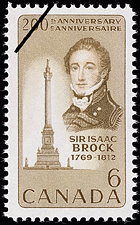
Sir Isaac Brock, 1769-1812, 200th Anniversary … Denomination: 6¢;
Date of Issue: 12 September 1969; Perforation: 12;
Printer/Quantity: Canadian Bank Note Company, Limited /35 100 000;
Creators: Designed by Imre von Mosdossy; Engraved by Yves Baril.
Historical Notice: Major-General Sir Isaac Brock, K.B., a man who died on Queenston Heights leading his troops in the successful defence of Canada, was born on the Island of Guernsey on 6th October 1769; the anniversary of his death occurs on 13th October. Brock, a tall man of imposing bearing, described by historians as unquestionably honest, is referred to as not only a gentleman but a gentleman. Although little is known of his father other than being a sailor, his mother, Elisabeth de Lisle, had been the daughter of the lieutenant-bailliff of Guernsey, a position comparable to that eventually assumed by Brock when, in 1811 he was appointed president and administrator of the Government of Upper Canada. He was a descendant of Sir Hugh Brock, a valiant knight in the reign of Edward III who had been in Brittany, then an English duchy; leaving Brittany, the family settled in the Channel Islands. A relationship existed between the Brock family and Lord de Saumarez, also a Guernsey man, who had distinguished himself at St. Vincent and at the Nile. The man eventually referred to as the Hero of Upper Canada entered military service at the age of 15; twelve years later he was gazetted lieutenant-colonel of his regiment and in 1811 elevated to the rank of major-general. It was with anything but elation that Brock received orders for the transfer of his regiment, the 49th, to Canada in 1802, the undeveloped land of some 300,000 people, his destination and destiny, was regarded as out of the mainstream of world events. In the following ten years he devoted great energy to familiarizing himself with Upper and Lower Canada, in the latter he put to good use in fluent command of French acquired during study under a French pastor-tutor at Rotterdam. So deeply rooted was his acceptance of responsibilities that in 1812 he chose to remain for the defence of Canada when offered a command elsewhere. Upon the outbreak of war with the United States of America in 1812 Brock had some 1450 British regulars under his command; organizing militia units to bolster his strength, he sought and won the cooperation of the native people, particularly the Six Nations Indians on the Grand River. Meeting with Tecumseh there was an immediate reciprocation of respect consequently the famed Indian leader led his people in cooperating. The morale of the defenders soared when one Brock’s first orders led to the fall of Detroit; later, the General’s insight led him to believe an assault would be made across the swirling, rushing Niagara River under the heights at Queenston. When the attack came, Brock fell mortally wounded, while leading his men to re-capture an 18 pouder. An enemy tribute to the recognized qualities of an adversary was evident when during burial. American guns boomed in unison with Canadian guns saluting a dead General. Some twelve years after death Brock’s remains were removed to a vault under a 135-foot monument on Queenston Heights; destroyed by an explosion in 1840, the memorial was replaced by the even more imposing 190-foot column which exists today.
More history … When war broke out between Great Britain and the United States in 1812, many zealous American politicians thought that Canada, then a British colony, would not resist invasion. They were wrong. Early in the war major-general Sir Isaac Brock scored two vital victories in defence of British North America. In August of 1812 Brock and his Indian ally Tecumseh took Detroit from General William Hull without a fight. Jubilant at this triumph, Brock moved on to Queenston Hights, the strategic key to the Niagara peninsula which the Americans had captured. In a daring move on October 13, Brock led his men straight up the slopes of the Heights to take it back. During the bold charge the general was killed, but his men continued, captured the position, and chased the Americans across the Niagara River. (37-I-19)

Canada Post Community Foundation: PermanentTM Domestic Stamps
www.canadapost.ca

Stamp value: PermanentTM, always worth the going rate, plus the 10-cent surcharge
on each stamp is a direct donation to the Canada Post Community Foundation;
Issue date: September 24, 2018; Stamp illustrator: Julie Morstad;
Stamp designer: Matthew Warburton , Emdoubleyu Design;
Quantity produced: 160,000; Dimensions: 24 mm x 32 mm.
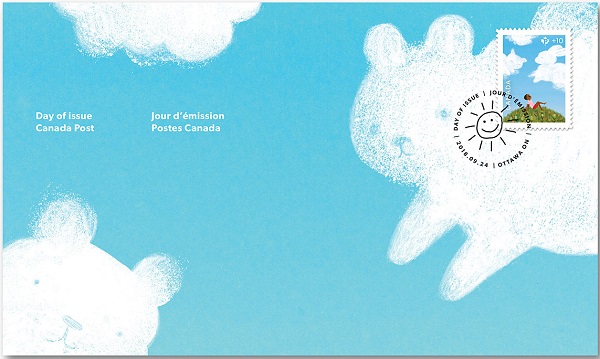
Remember the simple joy of looking for shapes in the clouds and help Canadian children and youth with this booklet of 10 PermanentTM domestic stamps. A 10-cent surcharge on the price of each stamp (or $1 per booklet) directly supports local and national non-profit organizations working to deliver a brighter future for young people in communities across Canada. The stamp is illustrated by award-winning children’s book illustrator Julie Morstad.
The Canada Post Community Foundation’s vision is to ensure children in Canada are happy, healthy and surrounded by a community that supports and cares for them. To date, the Foundation has provided more than $6 million in assistance to libraries, breakfast programs, anti-bullying initiatives, Kids Help Phone, Big Brothers Big Sisters of Canada, Boys and Girls Clubs of Canada, sports clubs, and many other worthy recipients. An additional $1.2 million was awarded in September, 2018. The stamp and collectible envelope are illustrated by award-winning children’s book illustrator Julie Morstad. The stamp is postmarked in Ottawa, Ontario, with a pictorial cancellation of a smiling sun and FDC quantity produced: 7,000; Dimensions: 190 mm x 112 mm.

2019 … $8 Pure Silver Coin –
Brilliant Cherry Blossoms: A Gift of Beauty
www.canadapost.ca www.mint.ca
A timeless beauty that will bloom year-round as part of your collection! Yours to keep or gift, this treasurable keepsake showcases the cherry blossoms that are a flowering symbol of friendship and goodwill in several Canadian cities. By combining selective colour and engraving, the pink-hued flowers on your coin’s reverse are forever in bloom and can be viewed year-round — especially when displayed in its folder-style packaging that easily transforms into an easel. Mixed in with the engraved branch, leaves and buds, the selective application of colour brings the soft pink-and-white flowers to life. The bilingual character on the reverse hints at the cherry tree’s origins and signifies “beauty” in Japanese and Mandarin. Each coin comes ready to display in its folder-style packaging, which easily converts into an easel.

Face value: $8 … Composition: 99.99% Pure Silver;
Mintage: While supplies last; Weight: 7.96 g;
Diameter: 27 mm; Finish: Specimen with colour;
Edge: Serrated; Artist: Anna Bucciarelli;
Packaging: Folder with easel back.
Design: Designed by Anna Bucciarelli, your coin is filled with bright, springtime cheer as it captures the peak splendour of a blossoming cherry tree. Selective colour and engraving are combined in this close view of a flower-laden branch, where the cluster of white and pink-coloured petals includes a number of engraved buds and leaves. The five-petal blossoms that have inspired countless artists are the very embodiment of “BEAUTY”, represented by the kanji character positioned just above the bough. The obverse features the effigy of Her Majesty Queen Elizabeth II by Susanna Blunt.
Did you know… *In addition to the chrysanthemum, the cherry blossom (sakura) is the national flower of Japan, where cherry blossom viewing (hanami) is an annual rite. *In China, cherry blossoms are regarded as a symbol of feminine beauty and power. *Since it is native to Asia, most of Canada’s flowering cherry trees were gifted or donated — including Vancouver’s cherry trees and those in Toronto’s High Park. *While the Yoshino cherry tree is the most popular cherry tree in Japan, the Kanzan cherry tree is more prevalent in North America.

2018 … $20 Pure Silver Coin – Four Seasons of the Maple Leaf
www.canadapost.ca www.mint.ca
A year in the life of… Canada’s most prominent symbol. Whether in spring, summer, fall or winter, Canada’s beloved sugar maple is a natural beauty in every season! This unusual collectible features an elongated outline that provides extra space for our tribute to a stunning feature of the Canadian landscape, where life moves to the natural rhythm of the four seasons. A symbolic shape: While the extended form provides extra space for the complex design, the egg shape is also a traditional symbol for rejuvenation and re-birth — an added nod to the sugar maple’s continuous cycle through the four seasons, beginning in the spring. A mix of technology, technique and design: Measuring 45 mm x 33 mm, this pure silver coin is a small-scale masterpiece! A dazzling array of finely engraved details can be found in the quadrants that represent the four seasons, as well as the close-up view of the leaf’s life cycle. A selective golden touch: Adding to the complexity of the design, selective gold plating adds a “sunlit” glow to the summer leaves, and a touch of warmth next to the polished proof shine of the wintry landscape. Re-creates nature’s colours: Two of Canada’s most colourful seasons are brought to life by selective colour, which re-creates the hopeful hues of spring and the spectacular nature of the sugar maple’s fall foliage.
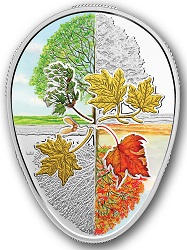
Face value: 20 dollars … Composition: 99.99% Pure Silver;
Mintage: 4,000; Weight: 31.82 g; Diameter: 45 mm x 33 mm;
Finish: Proof with colour and selective gold plating;
Edge: Interrupted Serrations; Artist: Margaret Best;
Packaging: Maroon clamshell with black beauty box.
Spring, summer, fall, and winter: Canada’s beloved sugar maple is naturally stunning in every season! Helped by a combination of artistic touches that stand-in for Mother Nature’s colour palette, each engraved quadrant on the reverse shows the maple’s progression from spring buds to winter-withered leaf. Your coin’s unusual contour is also significant: a traditional symbol for re-birth and renewal, the egg shape alludes to a timeless seasonal cycle that begins anew each spring.
Design: Like a “year in the life” snapshot of a Canadian icon, your coin’s image by Margaret Best traces the sugar maple tree and its leaf’s progression through the seasons. A finely engraved maple tree and its mirror image are each divided in half to create quadrants representing spring, summer, fall and winter, helped by artistic touches that stand-in for Mother Nature’s ever-changing colour palette. The coloured upper left quadrant steps into a spring landscape, where the maple’s branches are covered in the reddish-brown buds featured in the enlarged view near the centre. The engraved upper right quadrant leaps ahead to a mid-summer day, where selective gold plating mimics the effect of sunlight on the maple’s broad summer foliage. In the coloured lower right quadrant, the fall scene is a tapestry of brilliant red, yellow and orange hues that famously give Canada its fall colours, while the leaf’s curled edges allude to the seasonal shedding of leaves in preparation for winter. In the engraved lower left quadrant, the maple’s frosted silhouette embodies the resilient spirit of Canadians who embrace our northern climate, even in the face of winter’s fury, while the withered leaf is highlighted with selective gold plating for an elegant contrast. Coupled with the coin’s egg shape, which traditionally symbolizes renewal, the addition of a pair of maple keys is significant: the winged seeds represent the future of the maple and hint at the timelessness of this continuous seasonal cycle. The obverse features the effigy of Her Majesty Queen Elizabeth II by Susanna Blunt.

2018 … $250 Pure Silver Coin – The Voyageurs
www.canadapost.ca www.mint.ca
The Great Adventure … Get set for adventure with our first-ever kilogram coin featuring a unique oval and concave shape, with special finishes and ultra-high relief, that takes you to the Ottawa River where a team of voyageurs has just cleared a treacherous cascade, their canoe almost launching itself from this incredibly sculpted and immersive design. Limited to just 400 coins worldwide, this incomparable coin will be eagerly sought after by collectors of fine art and unique numismatic treasures. An epic masterpiece commemorating the voyageur, a key figure in Canadian history that continues to ignite the imagination today. This coin is a rare and upscale treasure to indulge the most dedicated history enthusiasts, especially those with a heightened interest in the fur trade and its daring voyageurs.
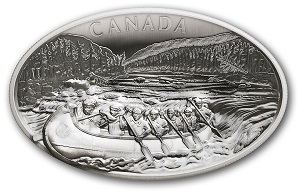
Face value: $250 … Composition: 99.99% Pure Silver; Mintage: 400;
Weight: 1,010 g; Diameter: 161.8 x 100.0 mm; Finish: Antique;
Edge: Serrated; Artist: Matt Bowen; Packaging: Custom wood box.
Get set for adventure with our first-ever kilogram coin featuring a unique oval and concave shape, with special finishes and ultra-high relief, that takes you to the Ottawa River where a team of Voyageurs has just cleared a treacherous cascade, their canoe almost launching itself from this incredibly sculpted and immersive design. Travelling to the Great Lakes was a gruelling voyage. Voyageurs paddled as much as 50 strokes a minute, and carried hundreds of kilograms across difficult portages. Their endurance, strength and courage were unimaginable, but the lure of money and adventure was stronger still. By the start of the 18th century, 25% of Montreal’s men were Voyageurs, regardless of class or social status. This population dropped as the population grew through the 18th century. To this day, Canada’s untamed waters continue to lure thrill-seekers into the wilderness.
Design: Your oval-shaped, concave, toned-and-lacquered coin is 99.99% pure silver. It has a long diameter of 161.8 millimetres and a short diameter of 100 millimetres, with a nominal metal weight of 1,010 grams. RCM engraver Matt Bowen has created this immersive design of Voyageurs paddling a canoe in the upper Ottawa River. They have just cleared a treacherous cascade, the force of the current almost launching the canoe from the coin’s ultra-high relief. Water churns beneath their paddles as the Voyageurs move in unison, their quick and coordinated strokes ensuring they pass through the rapids intact. Deeply carved boulders give rise to formidable riverbanks where the white water begins. In the distance, the river disappears around a bend, its shores choked with coniferous trees that greatly enhance the sense of perspective and the vastness of the landscape.
Did you know… * Voyageurs were the carriers of the fur trade from the 1690s to the 1850s. They worked 14-hour days as they travelled routes that spanned 3,500 km which some did not survive. While the majority were French-Canadian and Metis, there were English, German and Iroquois Voyageurs as well. * Inexperienced paddlers would begin as milieus (middlemen) in the centre of the canoe. The avant (bowman) was located at the front to guide the canoe, and instructed the gouvernail (steersman) at the back. Their positions earned twice the wage of the milieus. The highest post was the express, travelling twice as fast to transport important messages and individuals. * The Voyageurs’ workday often began at 3 am, and breakfast was usually eaten on a beach before 8. No other lengthy rests were allowed, except those forced by inclement weather, but paddling would cease for a few minutes every hour so the men could smoke. These breaks were so important that distances were measured in “pipes.” A 32 km lake would be four pipes long, depending upon wind and waves. * Voyageurs were also known as “engagés” (“contract employees” in French) as they performed a variety of roles for the fur trading companies. “Freemen” were independent trappers and traders who were not bound by any employment contract. * Feeding men who were burning 5,000 calories a day was a major challenge. With no time for fishing, portable, high-energy food became essential, and pemmican was the key. Made from dried caribou or bison, pemmican could be preserved for almost a year, and just 226 g of the highly concentrated food equalled 3.6 kg of fresh meat or fish.

2019 … 5-Ounce Pure Silver Coin – Big Coin Series: Dollar
www.canadapost.ca www.mint.ca
The Flying Loon dollar flies once more. In 1997, Canada’s beloved loonie celebrated its 10th anniversary. To mark the occasion, wildlife artist Jean-Luc Grondin created an alternate version of the coin’s iconic reverse by depicting the loon splashing across the lake during take-off. Sight unseen since 1997: The reverse design hasn’t appeared on any other coin since 1997, when it was featured on the 1997 Proof Dollar and the specimen dollar exclusive to the “Oh ! Canada!” and 1997 Specimen sets. Silver and gold, together on one coin! New for 2019: Reverse gold plating adds a warm-toned gleam that creates a beautiful contrast next to the silver shine of the engraved relief. A premium proof piece: Part of the Royal Canadian Mint’s annual Big Coin Series, a highly sought-after series of 5 oz. 99,99% pure silver versions of current and historical Canadian circulation coinage. Lower mintage: Mintage has been lowered from 1,500 to 1,250 in 2019 – the lowest ever for the popular Big Coin Series, which has a history of selling quickly.
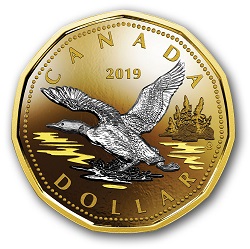
Composition: 99.99% Pure Silver; Mintage: 1,250; Weight: 157.6 g;
Diameter: 65.25 mm; Finish: Proof with reverse gold plating;
Edge: Serrated; Artist: RRC;
Packaging: Maroon clamshell with black beauty box.

2019 … $30 Pure Silver Coin – Fancy Dance
www.canadapost.ca www.mint.ca
Colour and engraving capture the pageantry of a modern powwow dance style. The purposeful movements of a powwow dancer stir the soul as they move to the rhythmic beat of the drum. Within the circle, complex footwork and acrobatic feats entertain and tell a story – for every symbolic gesture is a shared heartbeat reaching out, connecting with every observer, in a powerful expression of identity, spirituality, and heritage. All the colour and pageantry: A colour-filled celebration of today’s powwow as a cherished cultural custom! Mix of colour and engraving: The fancy dancer dominates a reverse design that is brimming with energy, thanks to the artful blend of colour and engraving. Crafted from 99.99% pure silver: Given its theme and high visual appeal, this coin is sure to be a prized addition to any collection, a matchless gift for any art or history enthusiasts, or a treasured keepsake for all who share an interest in Indigenous culture and art.
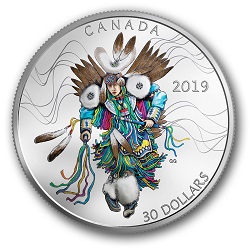
Face value: 30 dollars … Composition: 99.99% Pure Silver;
Mintage: 3,500; Weight: 62.69 g; Diameter: 50 mm;
Finish: Proof with colour; Edge: Serrated; Artist: Garrison Garrow;
Packaging: Maroon clamshell with black beauty box.
It is at once dazzling and colourful, energetic and fast-paced! A spectator favourite at many competitive gatherings, the Fancy Dance is one of the more recent additions to powwow dance categories. A fancy dancer must possess athleticism and stamina to perform this freestyle dance, which may include spins, twirls, or even flips, all while staying in time with the drumbeats and chants. Fancy Dance regalia are elaborate and unique – every element is a deeply personal expression of one’s lineage, heritage, and/or personal journey. Typically, a fancy dancer wears colour-coordinated feather bustles: one behind the shoulders and another behind the hips, along with arm cuffs. A breastplate made from hair-pipe (bone) beads may be worn over the beaded bodice. The dancer’s moccasins may also be topped with bells that ring out with every spirited step, while the swaying feathers of the hair roach accentuate the physicality of it all. The purposeful movements of a powwow dancer stir the soul as they move to the rhythmic beat of the drum. Within the circle, complex footwork and acrobatic feats entertain and tell a story – for every symbolic gesture is a shared heartbeat reaching out, connecting with every observer, in a powerful expression of identity, spirituality, and heritage.
Design: Designed by Kahniakehaka artist Garrison Garrow, your coin captures the fast-paced energy of a modern powwow dance style: the Fancy Dance. A fancy dancer dominates your coin’s design, where finely detailed engraving adds a sense of fast-paced movement while an application of colour highlights the intricate nature of the regalia. From the Thunderbird of the Plains peoples to the Iroquois design on the apron, the assemblage of motifs, textures and traditional elements (including the sacred eagle feathers) holds special meaning and speaks to the powwow’s importance as a vibrant, cross-cultural exchange. The obverse features the effigy of Her Majesty Queen Elizabeth II by Susanna Blunt.
Did you know… * The Fancy Dance originated in the United States – specifically, Oklahoma – during the early 20th century, when it was performed for entertainment purposes. It gradually caught on in other regions, and has since become one of the most popular dance categories at today’s competitive powwows, where dancers are judged for their dancing abilities and their regalia. * A fancy dancer’s hair roach may include eagle feathers, just like the bustles; but if one such feather should fall, the dancing is stopped and a special ceremony is held to retrieve this sacred object. * Colours also carry special meaning: black is associated with death, the underworld or the night; blue can represent a female, the sky, sadness, thunder or lightning. Green is the colour of the earth and plant life, of summers and rain. Red is the colour of blood and war, sunsets or thunder. White is associated with winter and snow, while yellow means sunshine and day.



The GTAPA is committed to promote and stimulate the art of philately
to all ages for fun, culture, education, and friendship.

